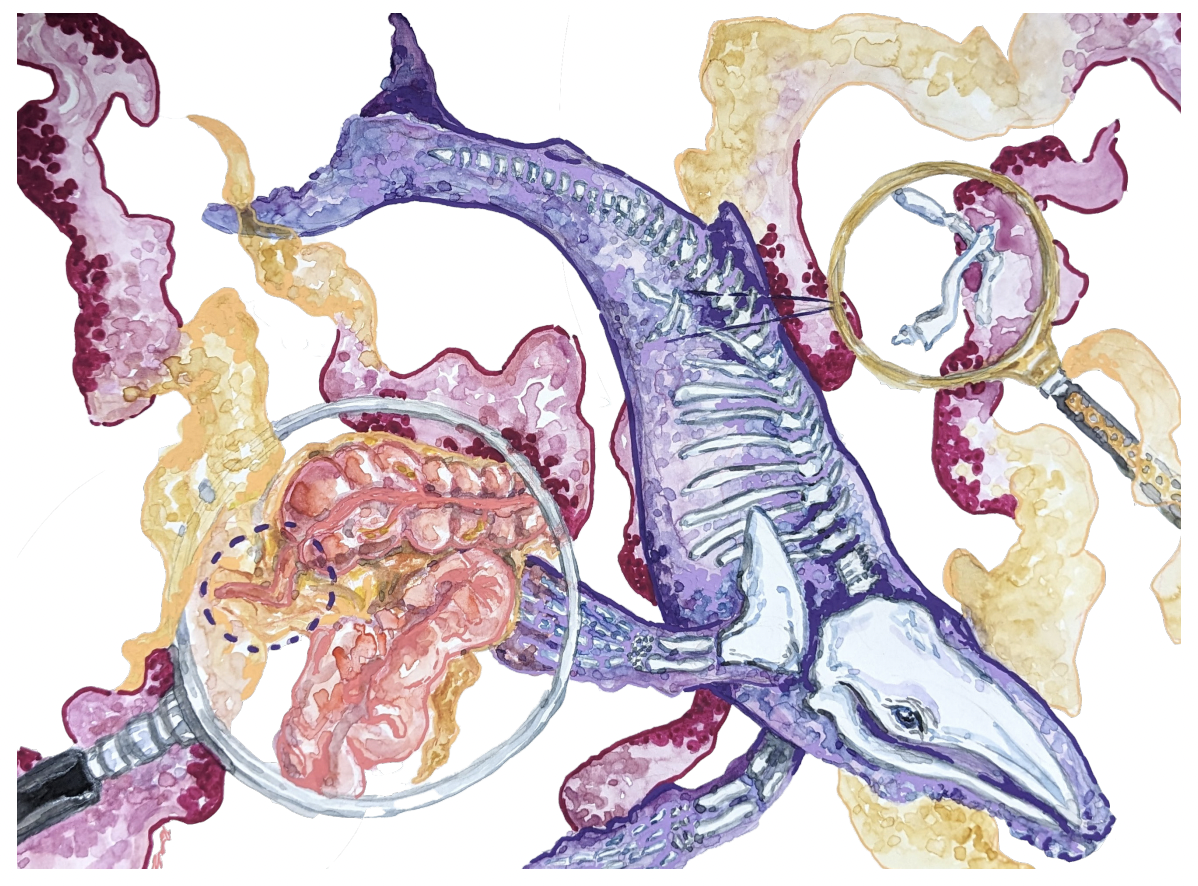Evolutionary relic turned medical breakthrough—seemingly redundant appendix may have more of a function than initially thought. Image credit: Peyton Cherry, The Oxford Scientist.
Vestige is a term derived from the Latin root vestigium, meaning ‘footprint’. What could evoke a greater sense of mystery than the mention of footprints?
Evolution has provided us a case not easily solved by surveying muddy trails. Our vestigial structures (such as our appendix, wisdom teeth, and coccyx) can present themselves as connections to our ancestral lineage, yet the puzzle behind their significance has left us scrambling to reveal the bigger picture.
It has been hinted by the likes of Charles Darwin in the Origin of Species (1859) that these ‘rudimentary, atrophied, and aborted organs’ can be perceived as anatomical relics, with once designated functions for survival now made redundant by our evolutionary pathway. This provides us with a rather simplistic view for today’s vestigial discourse. Not only does this posited product of evolution induce circular reasoning, but it also does not leave us much to investigate. If the mere existence of these organs is not enough to warrant our attention, then what about the risk of rendering them ‘useless’?
This mystery dives into an ironically conspicuous organ and most renowned advocate for vestigium: the appendix. Wrapped up in this vermiform machine is a history of speculation. The Darwinian thought behind appendiceal function was that it aided in the digestion of plant matter, such as tree bark eaten by our now-extinct herbivorous relatives. Due to changing culinary preferences towards a fruit-heavy diet, the need for a large caecum—the connection between the small and large intestines of which the caecal appendix was part—diminished. The story could have ended here, but there remained some leaves yet to be turned.
The turn of the millennium saw research propel the intrigue and visibility of the appendix. Though Darwin’s theory strongly aligned with appendiceal development in the great apes, research using phenotypic diversity analysis has shown that the appendix itself is likely to have evolved independently in mammalian species at least 32 times, from wombats to orangutans. So, it appears that changing diets, though coincidental with cecum reduction in the great apes, does not appear to have been the deciding characteristic in the formation of the appendix. This refutes Darwin’s general and causal theory of appendiceal derivation from the caecum, in light of the significance of the positive correlation between caecum size and appendix length.
The turn of the millennium saw research propel the intrigue and visibility of the appendix.
In human foetuses, the appendix had been known to harbour endocrine cells, which at the 11th week of development release peptide hormones and biogenic amines to aid in local homeostasis of proteins (proteostasis) by acting as neurotransmitters. Following recent studies on the reservoir of microbiota in the appendix, entering adulthood the organ assumes a crucial role in acting as a sort of sanctuary for “good bacteria” responsible for repopulating the gut after a purge.
In fact, appendectomy—a procedure used to treat severe appendicitis—is understood to disrupt the distribution of the gut organismal composition, which may also contribute to a greater likelihood of re-infection after initial recovery from an immune response. The plot thickens. Present in the appendix is the highest concentration of gut-associated lymphoid tissue (GALT), and with rising trends in cases of antibiotic-resistance, the appendix has become an organ of interest in studying immunological regulation.
In terms of medical breakthroughs, the appendix is no stranger to leading the surgical stage. Once being actively removed during surgical operations as a preventative form of healthcare, the appendix is no longer viewed as a liability best discarded. The appendix has placed itself in the future of reconstructive surgery, established in patients with bladder cancer: the organ has been used as a replacement of the sphincter muscle and ureter substitution during neobladder reconstruction as a result of iatrogenic injury (illness following medical treatment).
The appendix has placed itself in the future of reconstructive surgery…
Dissecting the layers behind the appendix, we reveal it has much more to offer science than being the most common cause of going under the scalpel. Laid before you, dear reader, is a case of evolution, not necessarily of an organ itself but of the vestigial concept. Moving away from the fractured view of vestigial structures, the re-evaluation of our relationship with them unleashes a plethora of opportunities to listen to our gut instinct and uncover this paradoxical case of useful vestige.
To be, or not to be, vestigial?





